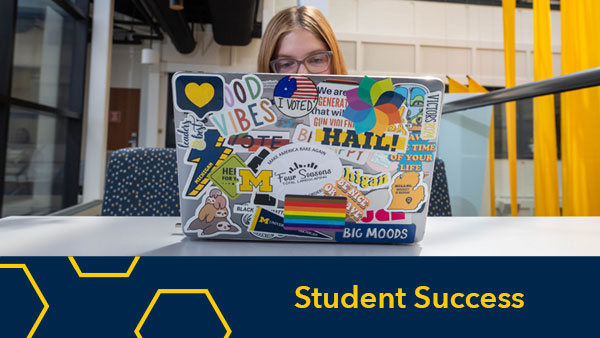Eleanor Daftuar, Senior Media Designer
Eric Joyce, Lead Marketing Specialist,
@EricMJoyce
Ellen Kuhn, Public Engagement Specialist
Benjamin Morse, Design Manager
In July 2019, the Center for Academic Innovation’s Teach-Out Team partnered with John Pasquale, DMA, Donald R. Shepherd Associate Professor of Conducting and Director of the Michigan Marching and Athletic Bands, and Malinda Matney, PhD, Director of Assessment for the Center for Research on Learning and Teaching and adviser for Kappa Kappa Psi, the national honorary band fraternity, to create the “Arts and Technology Teach-Out.” Hosted on Instagram throughout the month of July 2019, this Teach-Out was a unique experiment for the evolving Teach-Out model. The following are perspectives on the design, production, promotion, and engagement process behind this Teach-Out from four collaborators at the Center for Academic Innovation.
Benjamin Morse, Design Manager

We launched the Teach-Out on Instagram in a first-of-its-kind experiment using social media to facilitate and host an online learning experience. As part of this experiment, we hoped to break out of the traditional learning management systems (LMS), such as Coursera or edX, to explore ways different types of learners interact with our Teach-Out content within a social media platform. We looked for ways to connect with broad communities of artists, educators, technologists, and others; and Instagram emerged as a digital space in which many of these people were already engaging with one another.
Reflecting on the experience, Malinda Matney said, “This was a great chance to bring together threads from the varied elements of my professional life to share with others. Having this space to share these passions, and being able to do so with great thought partners, was invigorating.”
Similarly, John Pasquale said, “I really enjoyed the convergence of content and presentation to create a unique learning experience. It was fascinating to integrate a comfortable setting (the content) with a new and uncomfortable one (Instagram). While opinions varied within the scope of the project, the presentation was delivered in a meaningful way and reached a demographic not typically associated with the Teach-Out.”
Eleanor Daftuar, Senior Media Designer
Instagram relies heavily on imagery to drive various content feeds. Our production team created a visual patchwork of perspectives, enhanced by many exciting locations across campus. To the best of our abilities, we recorded each conversation in a setting that was meaningful to the interviewee, or related to their work. This added comfort resulted in passionate storytelling across 18 video interviews.

The biggest challenge was editing videos to fit within Instagram’s constraints. Instagram’s main feed requires videos to be 60 seconds or fewer. “Stories,” which expire after 24 hours, can only be 15 seconds each. IGTV (Instagram TV) allows users to upload videos up to 10 minutes in length. IGTV was used sparingly to publish videos captured in real-time with mobile devices. We published Stories more frequently, using them to promote online activities and release content that did not fit within the major themes of the Teach-Out.
Our primary method of publication was posting to the main content feed. Since we initially conducted long-form interviews—sometimes upward of 30 minutes—with each participant, we needed to select several 60-second excerpts from each interview in order to meet Instagram’s content requirements. We then grouped the 60-second excerpts thematically, and released them throughout the month of July. Each post in the main feed was fully captioned for increased accessibility.
Eric Joyce, Lead Marketing Specialist
This experiment naturally required an Instagram account in order to host both the content and resulting conversation for the Teach-Out. It seemed inappropriate to ask our faculty leads to leverage their personal Instagram accounts for the purposes of this experiment, yet no Instagram account existed for either the Center for Academic Innovation or Michigan Online. We considered if it made the most sense to create a new account for this Teach-Out, the Teach-Out Series as a whole, or a brand-level account for Michigan Online. After weighing several factors, we settled on creating a new Instagram page for Michigan Online — an idea we had considered prior, but a decision that was expedited by the launch of this Teach-Out. Doing so gave us the opportunity to launch the new account nearly simultaneously with the start of the Teach-Out to provide immediate value for our Instagram followers while also providing the flexibility for our teams to leverage this channel into the future. This led to the concept of the “Teach-Out Takeover” of this new Michigan Online Instagram account.
 By framing this experiment as a “Teach-Out Takeover,” it provided the faculty, design, and production teams the flexibility they needed to schedule and publish content — sometimes in real-time — and interact with participants in the service of the Teach-Out model. We conducted a short training workshop with faculty and provided a temporary account password a few days prior to the Teach-Out, which was later changed upon conclusion of the Teach-Out.
By framing this experiment as a “Teach-Out Takeover,” it provided the faculty, design, and production teams the flexibility they needed to schedule and publish content — sometimes in real-time — and interact with participants in the service of the Teach-Out model. We conducted a short training workshop with faculty and provided a temporary account password a few days prior to the Teach-Out, which was later changed upon conclusion of the Teach-Out.
Throughout the duration of the Teach-Out, 128 total videos and photos were published on Instagram in addition to 18 stories. There were a total of nearly 837,000 views of this content and 8,346 engagements (likes, comments, story replies, profile clicks, etc.). We should note, some of this content was supported by a paid advertising campaign to expand the reach of this content to artists on Instagram. Seeing this response is encourages us to consider future opportunities to host similar “Teach-Out Takeovers” on Instagram, Facebook, or through another social media channel.
Ellen Kuhn, Public Engagement Specialist
One of the exciting opportunities with this off-platform experiment was the possibility of engaging Teach-Out learners in different ways. In Coursera, learner engagement primarily involves responding to questions posed in discussion forums; on Instagram, learners can post comments, respond with emojis, tag others, or simply “like” a post. These options encouraged us to think about engagement differently. In fact, we decided to launch a whole sub-experiment for this Teach-Out; we created a scavenger hunt in which participants could find and document the intersections of art and technology in their own lives. For example, participants could find and post about an instance where they think technology poses challenges to creating art. We even offered a really awesome prize for U.S. participants tickets to a U-M football game with a special tour offered by our faculty hosts, Malinda Matney and John Pasquale. Interestingly, we did not end up seeing engagement with the scavenger hunt in the way that we had initially hoped. Perhaps it was too heavy of a lift, or perhaps Instagram wasn’t the right place to try something like that. Regardless, this sub-experiment left us with interesting design questions for the future as we consider new ways to encourage and appropriately scaffold learner engagement with Teach-Out content.
Teach-Outs are meant to be interactive learning experiences where participants can learn about, discuss, and address salient social issues in their own contexts. Instagram allowed our team to create unique opportunities for engagement and empowered participants to interact directly with John, Malinda, and other expert contributors. While engagement in discussion was less than we had hoped, this experiment will have lasting effects on how our team thinks about public engagement outside of a traditional LMS and the ways in which we design and launch future Teach-Outs (more about the model at Teach-Out.org).


